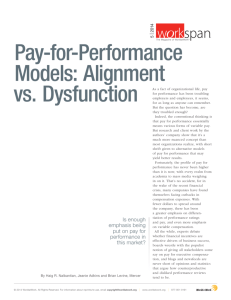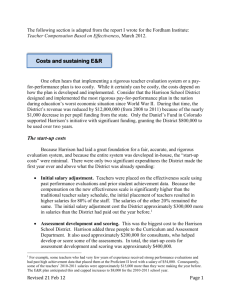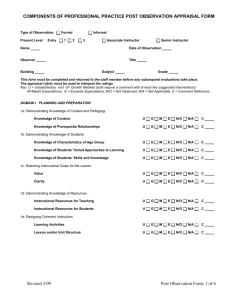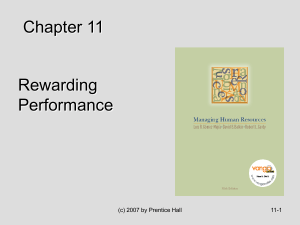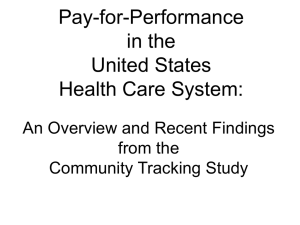Consider the effectiveness of your evaluation system
advertisement
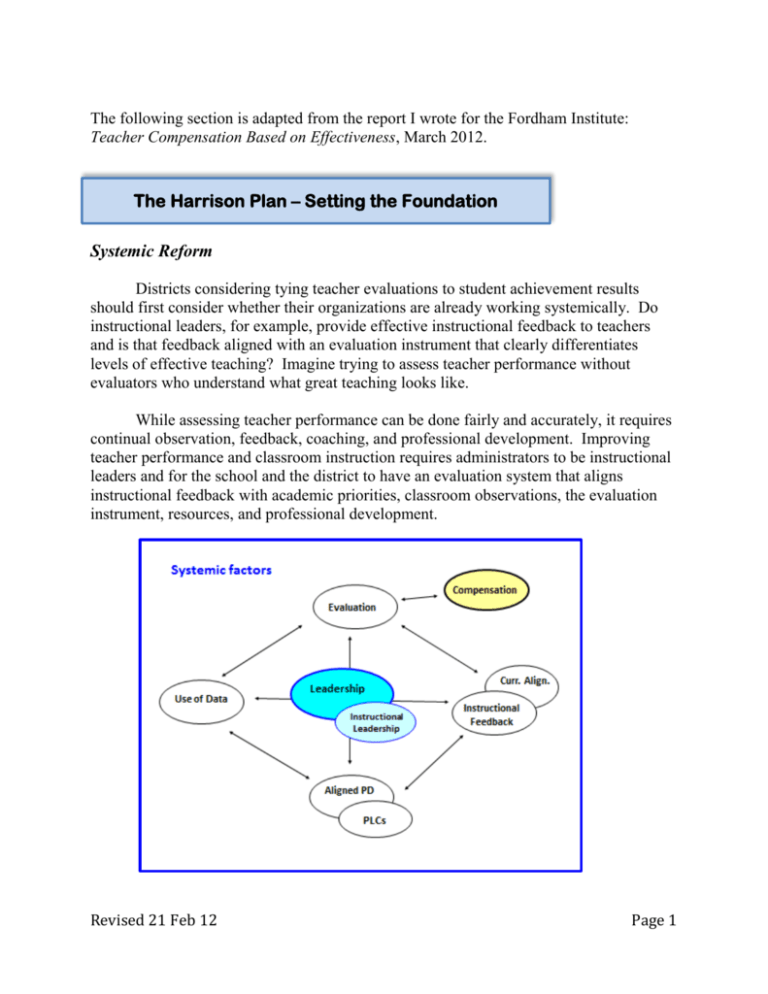
The following section is adapted from the report I wrote for the Fordham Institute: Teacher Compensation Based on Effectiveness, March 2012. The Harrison Plan – Setting the Foundation Systemic Reform Districts considering tying teacher evaluations to student achievement results should first consider whether their organizations are already working systemically. Do instructional leaders, for example, provide effective instructional feedback to teachers and is that feedback aligned with an evaluation instrument that clearly differentiates levels of effective teaching? Imagine trying to assess teacher performance without evaluators who understand what great teaching looks like. While assessing teacher performance can be done fairly and accurately, it requires continual observation, feedback, coaching, and professional development. Improving teacher performance and classroom instruction requires administrators to be instructional leaders and for the school and the district to have an evaluation system that aligns instructional feedback with academic priorities, classroom observations, the evaluation instrument, resources, and professional development. Revised 21 Feb 12 Page 1 Any significant reform has to be systemic. Changing the teacher salary schedule will likewise need to be systemic. At least five other key areas need to be addressed in order to have a teacher compensation system based on teacher effectiveness and student outcomes. Reformed systems would include the following: 1) school leaders who understand what good instruction looks like and who are held accountable for improving the quality of instruction, 2) a culture of instructional feedback in which classroom instruction is observed and effective feedback is given regularly and consistently, 3) evaluation instruments that focus on the quality of instruction, differentiate teacher effectiveness, and include measurable and observable outputs/criteria of teacher effectiveness, 4) processes to collect and analyze student achievement data and teachers who use those data to improve instruction, 5) significant support and professional development that helps both administrators and teachers improve instruction, Because of the interconnectedness of the various parts of any educational system, simply initiating a pay for performance plan will not turn an ineffective or non-aligned organization into an effective one. 6) an aligned curriculum and a pervasive understanding of how to implement a standardsbased curriculum. Any attempt to implement a pay-for-performance system without first laying the groundwork for the areas listed above will probably result in teachers feeling that the compensation system is arbitrary or biased. For example, if teachers are not observed regularly and given effective feedback often, they could justifiably argue that the onetime-in-a-year evaluation does not accurately assess their performance. Also, if the reform is not systemic, school leaders will be unprepared to assess teacher effectiveness or will continue to assess them in a perfunctory way. 1 This could result in an inflated compensation system in which teacher compensation grows without concomitant increases in teacher effectiveness or student achievement. 1 This appears to be already happening in some school districts. If districts jump into pay-for-performance without laying the proper foundation, “good” pay-for-performance plans will fail before they have a chance to work. Revised 21 Feb 12 Page 2 Because of the interconnectedness of the various parts of any educational system, simply initiating a pay-for-performance plan will not turn an ineffective or non-aligned organization into an effective one. Conversely, an effective school will be made even more effective if the teacher compensation system is aligned with the other parts of the system. Indeed, alignment of all major parts of any system is required for the organization to maximize its effectiveness. The Harrison School District spent three years getting its system aligned before developing the specific pay-for-performance plan. Once such a foundation was laid, the District could move quickly, going from concept to implementation in one year. Principles and Parameters Principles There are numerous ways to design a pay-for-performance system. Still, the plan should be designed to help achieve the goals of the organization. Similar to the notion of form following function, the key elements of the system should also be tied to core principles and operational parameters. While the devil may be in the details of a pay-for-performance plan, the real debate should center on the principles that will guide development of the plan and that will help decide conflicts during implementation. These guiding principles should be established prior to the development of the details of a pay-for-performance plan. The Harrison plan was designed using the following principles or parameters: Student academic achievement results will count for 50 percent of a teacher’s evaluation.2 o Performance, especially the delivery of high quality instruction, counts for the other 50 percent. Colorado’s Teacher and Principal Effectiveness legislation (SB191), passed in May 2010, requires 50 percent of a teacher’s evaluation to be based on student achievement results by the 2013-2014 school year. HSD2’s plan preceded the passage of SB191. 2 Revised 21 Feb 12 Page 3 The HSD2 plan must focus on results. o There is a difference between “process” indicators and “results.” This principle applies even on the performance side of the equation. A process indicator is a teacher behavior that is observable and that generally can be assessed. However, it does not necessarily contribute directly to improved instruction or student achievement. For example, turning in lesson plans is a process indicator. While designing effective lesson plans is important and part of the teacher evaluation rubric, the ability to write lesson plans is not as important as the execution of the lesson plan and the delivery of effective instruction. Similarly, portfolios of student work (process indicator) hold less weight than on-demand demonstrations of student learning (outcome of effective teaching). The plan must include individual accountability. o A district could derive a teacher’s student achievement score based on the achievement scores of students the teacher actually instructs (individual accountability), or based on the aggregate scores of a larger group of students, such as students in the same grade, discipline, school, or district (group accountability). o In the Harrison plan, the predominant part of a teacher’s student achievement score is tied to the achievement scores of students the teacher actually instructs (individual accountability). The plan must be fair, accurate, and rigorous; it may not always be equitable. o While the District strives for equity in a number of areas – class size, availability of textbooks, amount of instructional time – it recognizes that schools have some degree of autonomy and that there will always be differences. The HSD2 plan does not attempt to take into account differences in class size, the number of English language learners in a class, the number of minutes devoted to teaching reading in a school, etc. The plan must include all classroom teachers and must be equally rigorous for all grades and disciplines. o In order for the plan to be fair, the chance of a high school math teacher achieving a distinguished evaluation must be similar to the chance of an elementary art teacher receiving a distinguished evaluation. o It is the acceptance of this principle that requires the District to develop assessments for all grades and disciplines. Revised 21 Feb 12 Page 4 The HSD2 plan will compensate teachers based on their overall effectiveness and that compensation should be markedly differentiated. o The plan should be a true pay-for-performance plan, not an incentive pay plan. Teachers who are more effective should earn significantly more money than a less effective teacher. The implementation of the plan must be standardized. o The development, administration, and scoring of assessments, for example, should be standardized across the District. HSD2 will start “version one,” knowing that there will have to be revisions. o As Chip Heath and Dan Heath note in Switch, the key is to “look for a strong beginning and a strong ending and get moving.”3 3 Chip Heath and Dan Heath, Switch (New York, New York: Broadway Books, 2010), p. 93. Revised 21 Feb 12 Page 5
